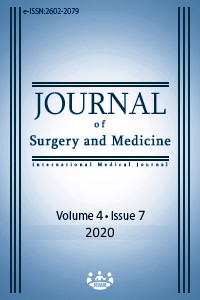Our arteriovenous fistula experiences with grafts in hemodialysis patients
Keywords:
Chronic kidney failure, Hemodialysis, Synthetic graft, Arteriovenous fistulaAbstract
Aim: In patients whose life is dependent on hemodialysis, the most suitable vascular access routes are arteriovenous fistulas made with native vessels. However, in patients whose natural vessels are depleted, or not suitable, arteriovenous fistulas can be opened with artificial grafts. Our aim is to examine arteriovenous fistulas opened with synthetic grafts in hemodialysis patients who do not have native vascular access in the upper extremity and share our results.
Methods: Patients who underwent opening of an arteriovenous fistula with a synthetic graft to the upper extremities in Adıyaman University Faculty of Medicine, Cardiovascular Surgery Clinic between December 2012 and December 2018 were examined in this retrospective cohort study. They were screened for age, gender, end-stage renal failure etiology, complications in vascular access site, postoperative follow-up, and duration of use. Primary and secondary patency rates were determined.
Results: It was determined that synthetic grafts were used in 33 (15 males, 18 females) out of 436 arteriovenous fistulas (AVF) opened to 372 patients. The mean age was 59.2 (17) years. Left radiocephalic (RC) straight graft fistula was opened in 2 patients, left brachiocephalic (BC) straight graft fistula was opened in 12, left BC distal loop AVF in 13, right BC distal loop AVF in 1, left brachioaxillary (BA) distal loop AVF in 3 and right BA distal loop was used to open an AVF in 2 patients. Primary cumulative patency rates were as follows: 72% in the 3rd month, 65% in the 6th month, 42.24% in the 12th month. The secondary patency rates were 33.9% in the 60th month, 12% in the 60th month, 96.96% in the 12th and 24th months, 90.28% in the 36th and 48th months, 59.12% in the 60th month and 43.11% in the 72nd month.
Conclusion: In chronic renal failure patients who do not have a natural vascular access routes or whose natural routes have been exhausted, AVFs that are opened to the upper extremities with a synthetic graft are suitable vascular access routes for long-term dialysis.
Downloads
References
Bozkurt O, Topal C, İnanç M. The relationship between dialysis adequacy and the rate of change in uric acid level by hemodialysis. J Surg Med. 2018;2(3):293-7.
Brescia MJ, Cimino JE, Appel K, Hurwich BJ. Chronic hemodialysis using venipuncture and a surgically created arteriovenous fistula. N Engl J Med. 1966;275:1089-92.
Hodges TC, Fillinger MF, Zwolak RM, Walsh DB, bech F, Cronenwett JL. Longitudinal comparison of dialysis access methods: risk factors for failure. J Vase Surg. 1997;16:1009-19.
Çekirdekçi A, Rahman A, Burma O, Cihangiroglu M. Polytetraflouroethylene {PTFE) Greftlerle Hemodializ Amaçlı Arterio-Venoz Fistül Uygulamaları. Damar Cerrahisi Dergisi. 2000;3:24-7.
Baker LD, Johson JM, Gold farb D:Expanded Polytetraflouroeethylene (PTFE) Subcutaneus Conduit: An İmproved Vascular Access for Chronic Hemodialysis. Trans Am Soc Artif İntern Organs 1976;22:382-7.
Albers FJ. Causes of hemodialysis access failure. Adv Ren Replace Ther 1994;1(2):107-18.
Beathard GA, Lok CE, Glickman MH, Al-Jaishi AA, Bednarski D, Cull DL, et al. Definitions and End Points for Interventional Studies for Arteriovenous Dialysis Access. Clin J Am Soc Nephrol. 2018;13(3):501-12. doi:10.2215/CJN.11531116
Leake AE, Yuo TH, Wu T, Fish L, Dillavou ED, Chaer RA, Leers SA, Makaroun MS: Arteriovenous grafts are associated with earlier catheter removal and fewer catheter days in the United States Renal Data Systempopulation. J Vasc Surg 2015;62:123–7.
Gibbons CP. Primary vascular access. Eur J Vasc Endovasc Surg. 2006;31(5):523-9. doi: 10.1016/j.ejvs.2005.10.006. Epub 2005 Nov 17. PMID: 16298148.
Kaufman JL. Revisional surgery for hemodialysis access. Sem Dial. 1996;9:41-50.
Ergüneş K, Yaşa H, Özelçi A,İlhan G, Gökalp O, Göktoğan T, et al. Hemodiyaliz Gerektiren Kronik Böbrek Yetmezlikli Hastalarda Arteriovenöz Fistül Oluşturmak İçin E-Politetrafloretilen Greft Kullandığımız hastalardaki Klinik Deneyimlerimiz. Damar Cer Derg. 2008;17(2):68-72.
Han S, Seo PW, Ryu JW. Surgical Outcomes of Forearm Loop Arteriovenous Fistula Formation Using Tapered versus Non-Tapered Polytetrafluoroethylene Grafts. Korean J Thorac Cardiovasc Surg. 2017;50(1):30-5. doi:10.5090/kjtcs.2017.50.1.30.
Roy-Chaudhury P, Kelly BS, Miller MA, Reaves A, Armstrong J, Nanayakkara N, et al. Venous neointimal hyperplasia in polytetrafluoroethylene dialysis grafts. Kidney Int. 2001;59(6):2325-34. doi:10.1046/j.1523-1755.2001.00750.x
Besarab A, Kumbar L. How arteriovenous grafts could help to optimize vascular access management. Semin Dial. 2018;31(6):619-24. doi:10.1111/sdi.12718
Gilliland M, Brown JS, Pryor L. Nursing Care for Patients with Synthetic Arteriovenous Grafts. Nephrol Nurs J. 2017;44(5):391-8.
Maya ID, Weatherspoon J, Young CJ, Barker J, Allon M. Increased risk of infection associated with polyurethane dialysis grafts. Semin Dial. 2007;20:616-20.
Kakisis JD, Antonopoulos C, Mantas G, Alexiou E, Katseni K, Sfyroeras G, et al. Safety and efficacy of polyurethane vascular grafts for early hemodialysis access. J Vasc Surg. 2017;66(6):1792-7. doi:10.1016/j.jvs.2017.06.083
Ryan SV, Calligaro KD, Scharff J, Dougherty MJ: Management of infected prosthetic dialysis arteriovenous grafts. J Vasc Surg. 2004;39:73-8.
Florescu MC, Qiu F, PlumbTJ, Fillaus JA. Endovascular treatment of arteriovenous graft pseudoaneurysms, indications, complications, and outcomes: A systematic review. Hemodial Int. 2014;18:785-92.
Balaz P, Bjorck M. True aneurysm in autologous hemodialysis fistulae: Definitions, classification and indications for treatment. J Vasc Access. 2015;16:446-53.
Ponce KLP, Tejada-Tayabas LM, González YC, Haro OH, Zúñiga ML, Morán ACA. Nursing care for renal patients on hemodialysis: Challenges, dilemmas and satisfactions. Rev Esc Enferm USP. 2019 Dec 2;53:e03502. Spanish, English. doi: 10.1590/S1980-220X2018011103502. PMID: 31800805.
Matsuura JH, Rosenthal D, Clark M, Shuler FW, Kirby L, Shotwell M, et al. Transposed basilic vein versus polytetrafluorethylene for brachial-axillary arteriovenous fistulas. Am J Surg. 1998;176(2):219-21. doi:10.1016/s0002-9610(98)00122-6.
Huber TS, Carter JW, Carter RL, Seeger JM. Patency of autogenous and polytetrafluoroethylene upper extremity arteriovenous hemodialysis accesses: A systematic review. J Vasc Surg. 2003;38(5):1005-11. doi:10.1016/s0741-5214(03)00426-9.
Bosman PJ, Blankestijn PJ, van der Graaf Y, Heintjes RJ, Koomans HA, Eikelboom BC. A comparison between PTFE and denatured homologous vein grafts for haemodialysis access: a prospective randomised multicentre trial. The SMASH Study Group. Study of Graft Materials in Access for Haemodialysis. Eur J Vasc Endovasc Surg. 1998;16(2):126-32. doi: 10.1016/s1078-5884(98)80153-6.
Downloads
- 590 951
Published
Issue
Section
How to Cite
License
Copyright (c) 2020 Cengiz Güven, Fatih Üçkardeş
This work is licensed under a Creative Commons Attribution-NonCommercial-NoDerivatives 4.0 International License.
















